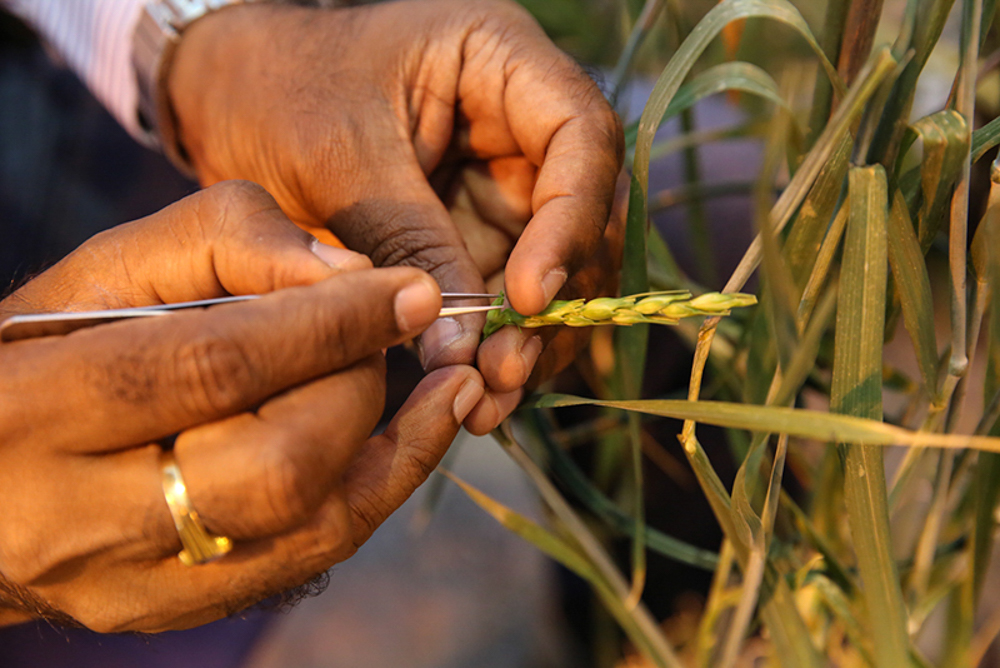Wheat
Triticum spp.
Wheat is the most important crop in the world in terms of area harvested (220 million hectares in 2014). The main types of cultivated wheat are the hexaploid bread wheat (T. aestivum), and tetraploid durum wheat (T. turgidum). Other types of wheat, such as einkorn, emmer and spelt, are still grown on a more limited scale in some regions, though interest has been increasing of late.
Wheat is the world’s most widely grown crop with a global production of over 600 million tons produced from about 210 million hectares in many different countries in Europe, Asia, North Africa and the Americas. The area sown to wheat has doubled over the past 50 years and production per hectare has almost tripled. This increase in production is due in part to the efforts of national, regional and international breeding programs to release improved cultivars.
Wheat is also the world’s most widely traded food grain, with about 105 million tons or about 18% of world production traded each year.
Wheat is expected to be negatively impacted by climate change. Due to its importance in diets and livelihoods, a global effort led by CIMMYT is harnessing the genetic diversity of wheat to produce more resilient, productive and nutritious varieties.
Production is based almost entirely on two species. Triticum aestivum, common or bread wheat, accounts for about 95% of world production and T. turgidum ssp. durum, macaroni or durum wheat, accounts for the other 5%. The remaining cultivated species are largely historical relics, though they can be locally important and are making a comeback in some places.
Types
Cultivated wheat species belong to three ploidy groups with chromosome numbers of 2n = 2x = 14 (T. monococcum), 28 (T. turgidum and T. timopheevii), and 42 (T. aestivum and T. zhukovskyi).
Other classifications divide wheats into hulled and free-threshing, and spring and winter types.
Collecting
Collecting Projects
Cultivation and domestication of wheat began around 12,000 years BP in the area known as the Fertile Crescent in the Middle East. From there, the crop spread to the Near East (9000 BP). The dispersal of the crop into Europe occurred through Greece (8000 BP). It reached the Balkans, the Danube, and southern Europe by 7000 BP. Wheat was brought to China through Iran and Central Asia (3000 BP), and it entered Africa through Egypt. The Spanish introduced the crop to Mexico in the 16th century. From there, wheat spread widely through Europe and Asia and then to the Americas.
Use
Pre-breeding Project
Collections
Globally, there are more than 80 wheat collections, holding more than 800,000 accessions. It is commonly assumed that there is substantial duplication of accessions within and among collections, though further research on the extent of this duplication is required.
The International Maize and Wheat Improvement Center (CIMMYT) hosts the largest wheat collection in the world, followed by the USDA-ARS genebanks, the Australian Grains Genebank and ICARDA.
The Vavilov Research Institute (VIR), Russian Federation, NBPGR, India and Instituto del Germoplasma, Bari, Italy each hold about 30,000 accessions. Several smaller, specialized collections of wild wheat relatives and genetic stocks are important for the diversity they hold for future breeding and research.
Almost 320,000 wheat accessions are visible on Genesys. Nearly 23% of these are landraces, and about 7% are wild relatives.
The global ex situ conservation strategy for wheat, rye and triticale provides a framework for the efficient and effective ex situ conservation of the globally important collections of wheat, rye and triticale.
Conservation
Wheat is conserved as seeds.
- Modern and obsolete improved varieties are generally well conserved.
- Landrace varieties continue to be a priority for conservation as a result of the increasing threat of disappearance by the spread of improved modern cultivars.
- Wild relatives tend to be poorly represented in global ex situ collections because:
- Their seeds tend to shatter more than those of crop cultivars, so seeds are more difficult to capture, increase and maintain.
- Field regeneration is problematic due to their potential to become introduced weeds in the surrounding environment.
- They were usually seen to be less threatened with extinction, because they are able to reproduce in nature. Unfortunately, changes in land use mean that many of these populations are now at risk of becoming extinct.
COLLECTING PARTNERS
- Aegean Agricultural Research Institute
- Agricultural Plant Genetic Resources Conservation and Research Centre (APGRC)
- Agricultural Research Institute (ARI) of the Ministry of Agriculture, Natural Resources of Environment
- Institute of Botany of Ilia State University (IoB)
- Armenian Botanical Society (ABS)
- Genetic Resources Institute (GRI) of Azerbaijan National Academy of Sciences
- Lebanon Agricultural Research Institute (LARI)
- University of Pavia
PRE-BREEDING PARTNERS
- University of Nottingham
- International Maize and Wheat Improvement Center (CIMMYT)
- International Center for Agricultural Research in Dry Areas (ICARDA, Morocco)
- Institute National de la Recherche Agronomique (INRA)
- Institut Sénégalais de Recherches Agricole (ISRA, Senegal)
- Ethiopian Institute of Agricultural Research (EIAR)
- Lebanon Agricultural Research Institute (LARI)

